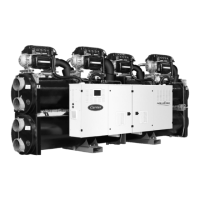8.14 - BACnet (option 149)
The BACnet/IP communication protocol is used by the building
management system or the programmable controllers to
communicate with the Touch Pilot interface. It is activated if the
optional BACnet activation key (dongle) is present on the electronic
control board.
This option may be ordered and installed on site. The BACnet
prole of the Touch Pilot interface is B-ASC.
For more information about BACnet, please refer to the BACnet
document included with the control or contact Manufacturer
Service Agency.
8.15 - Dry cooler (option 154)
19PV units have been specially designed to optimise the operation
of split installations, using air-cooled condensers as the chiller heat
rejection system.
19PV units can control a Carrier dry cooler to cool down the
condenser water loop. This air exchanger includes all compatible
control electronics.
8.15.1 - Condensing pressure control
The control conguration of this functionality must be done by
a specially trained and qualified engineer during the unit
installation. The Manufacturer supplies specic documentation for
this operation to the trained engineers.
The Touch Pilot control system includes logic to permit the control
of different xed and variable-speed fan variants.
Touch Pilot continuously optimizes system operation to obtain the
best system efciency by controlling the number of fans required
for any thermal load and outside temperature conditions.
8.15.2 - Condensing setpoint
The condensing setpoint is adjustable in the Setpoint menu
(SETPOINT).
Condensing setpoint
Minimum value 27°C
Default value 35°C
Maximum value 49°C
The condensing setpoint can be reset by reference to the outside
temperature to optimize the operation of the condensing system.
To set the condensing setpoint reset, the following adjustments
are necessary:
- hr_sel (Heating Reset Select) set to “1” (OAT) in the Reset
Conguration menu (RESETCFG).
- oat_crno (OAT no reset value), oat_crfu (OAT full reset value)
and hr_deg (heating reset degree value) must be set in the
Reset Conguration menu (RESETCFG). See also section
8.4.2 for more information about reset control.
8.16 - Dry cooler free cooling (option 313)
19PV units may come with the free cooling option that enables
the control of a Carrier dry cooler. The chiller and the dry cooler
have to be connected through a LEN RS-485.
Units tted with a dry cooler provide the “free cooling” functionality
which means that the chilled water system directly exchanges
heat using the air-to-water heat exchanger (“dry cooler”).
For chillers with this option, the Touch Pilot control may use low
outside air temperature to cool down the water loop and satisfy
the cooling demand.
The dry cooler is used not only to assist in producing cooling water
to meet the current cooling demand but it also allows for reducing
energy consumption.
The dry cooler comes with up to 20 fans, i.e. xed-speed or variable-
speed fans, which can be installed in different congurations. The
Touch Pilot control distinguishes between two types of fan control
for a dry cooler free cooling option, where the rst one embraces
the use of fan staging and the second one includes the use of
variable-speed fans. Mixed conguration can also be used (xed
and variable-speed fan control at the same time).
8.17 - Master/Slave control
The control system allows for master/slave control of two units
linked by the network. The master unit can be controlled locally,
remotely or by network commands, while the slave unit remains
in Network mode.
All control commands to the master/slave assembly (start/stop,
setpoint selection, heating/cooling control, load shedding, etc.)
are handled by the unit which is configured as the master.
The commands are transmitted automatically to the slave unit.
If the master chiller is turned off, while the master/slave function
is active, then the slave chiller will be stopped. Under certain
circumstances, the slave unit may be started rst to ensure that
the run times of the two units are equalised.
In the event of a communication failure between the two units,
each unit will return to an autonomous operating mode until
the fault is cleared. If the master unit is stopped due to an alarm,
the slave unit is authorised to start.
IMPORTANT: Master/slave assembly can be congured only
by service technicians.
8 - STANDARD CONTROL OPERATIONS AND OPTIONS
29

